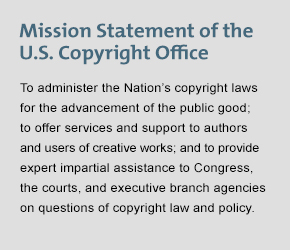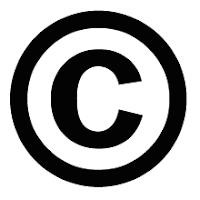The following discussion about Copyright is a summarized adaptation from the University of Maryland University College's (UMUC) article titled
Copyright and Fair Use in the UMUC Online or Face-to-Face Classroom.
 |
| The Mission Statement of the U.S. Copyright Office |
An Introduction to Copyright
Copyright is a legal tool that allows the creator of a work of art to control how that work is used. Copyright provides the motivation needed for the artists and creators of these works to continue to make new works. There are, however, some restrictions to copyright. Only tangible works can be copyrighted. These types of works must meet three main requirements to qualify for copyright protection. The requirements are as follows. First, the work must be documented or
fixed. This means that the work must be written or recorded in some way to be protected. Second, the work must be an original work. This means that the one who seeks copyright protection for the work must be the one who actually created the work. Third, the work is only required to meet
minimally creative guidelines. This means that the author or artist only needs to deviate slightly from the original piece as long as it goes above and beyond what was contained in the original to gain copyright protection. There are some things that are not covered by copyright laws. Works found in the
public domain do not qualify for copyright protection. These types of works include, but are not limited to, ideas, facts, blank forms, and words or names. Copyright protects the right to copy, sell, or perform the protected work for public use.
An Introduction to Fair Use
 |
| Diagram of Fair Use Factors |
Fair use is, perhaps the most important aspect of copyright laws. Fair use places restrictions on an author's exclusive rights to a work. Deciding what is fair use of a work is subject to the judgement of the individual seeking to use the work, however, there are several criteria that must be met. One must consider the purpose and character for using the work. For example, is the use of a work going to be a direct copy? If the answer is "yes," the use of the work would not be fair. On the other hand, if the work is going to be used for educational purposes in a classroom, use of the work is likely to be considered fair. Next, one must consider how much of the original work will be used. The lower the percentage of the work used, the better the chances of the use being considered fair. For example, using 50% of a work is not likely to be considered fair use, while using only 10% would be considered fair. Lastly, one must consider the effect the use will have on the original. For example, if the use is geared toward the same audien
ce with minimal originality, it will likely be considered an infringement and unfair use. To further protect oneself in using the works of others there are several things to remember. The user of the work should make needed copies as close to the time of use as possible and should not use the work continually for a long period of time without obtaining permission from the owner of the work. Examples of what can appropriately be copied and used include a chapter from a book, a single article from a magazine, charts or graphs, and about 10% of longer works. It is best to avoid using works for corporate purposes, using the work repeatedly, and using a work in it's entirety. The UMUC Library can assist in obtaining permission to use works if needed. When using works found online it can be more difficult to obtain fair use permission. In such cases it is important to credit the source of the original work.
UMUC Educational Multimedia Guidelines
 |
| A Photo of the Copyright Symbol |
The guidelines for Educational Multimedia use of copyrighted material have been established by the U.S. Copyright Office. In an attempt to define the guidelines, it is specified that they are in place for using the instructor's personal material such as lecture notes. It is also noted that the guidelines are voluntary and are a safe minimum for ensuring fair use of material for educational purposes. There are time restrictions in place, as well as guidelines for students and faculty. Students are suggested to use only a portion of the copyrighted material when creating a project for a specific course. Faculty members are suggested to use only a portion of copyrighted material when creating multimedia presentations for instructional purposes within educational facilities. The time restrictions allow the user of the copyrighted material to use the work for up to two years, at which point permission must be obtained. Limits on the amount of copyrighted material that can be used vary based on what the media is. For example, motion media, text, and music allow a maximum of 10% of the total work to be used without permission while photographs have more detailed restrictions. Permission before use of a copyrighted work should be obtained if the material will be used for corporate purposes, if more than two copies of a project will be made, or if there is any doubt that the planned use will not meet the fair use guidelines. The UMUC Library has more information about obtaining permission to use copyrighted materials.



No comments:
Post a Comment